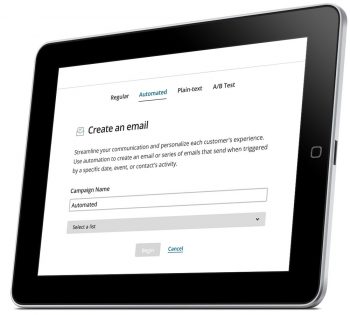5 Dec 2017
We all know social media is a necessary evil of modern veterinary practice. However, as Julia Bramble spotlights, it can be used as a powerful, bottom line-boosting tool…

Figure 1. An example of a practice encouraging its social media audience to come and meet them in real life.
Social media is the new black. Most businesses recognise they need to have a presence as it is where potential customers are spending their time – and rule number one of marketing is to be where your customers are.
However, a big difference exists between having a presence on social media and using it successfully to bring in leads and clients.
This article covers the key things you need to get right to gain these results from your social media marketing.
These “things” fall into two broad categories – making sure you attract and connect with the right people, and making sure you nudge them towards doing business with you.
Social media marketing is great for raising brand awareness, but successful strategies focus on building relationships with potential clients before, during and after they are ready to buy.
This not only requires a different approach from the more traditional “push” marketing methods, where you put your message in front of customers with no interest or desire in buying your product or service. It also relies on you knowing who your ideal clients are – for example, what they are interested in, how they spend their time and what matters to them. This helps you speak their “language”, so you can naturally engage with them online.

Many businesses are so focused on building an audience on social media they forget to ascertain whether the fans and followers they are attracting are the right people for them.
Businesses also do not realise they can influence who follows them, on any platform, with the content they share. For example – if your practice shares only funny photos of cats, you may find your fans and followers are people who love cat photos or funny photos, but do not own a cat.
However, if you post updates that include the odd funny cat photo (because, well, who doesn’t love a funny cat?), but also answer questions committed cat owners would ask, or share stories of how your services have helped to enhance the lives of your furry clients, you are going to attract cat owners. You will also position your practice as experts in cat care and, naturally, encourage your audience to build trust in you, which, as we all know, is vital to attracting new clients.
Also, embrace the fact social media is about being social. No matter how great someone thinks your content is, if he or she comments or asks a question and never gets a reply, or sees you using the platform only as a digital billboard, he or she is not going to be interested in finding out more about your business.
In summary – share content that will appeal to the right people for you, and be as proactive as possible in engaging them in conversation and helping them.
Attracting new clients from social media will happen, but relying on this alone is not going to give you the results you want.
As humans, we invariably need a nudge in the right direction to get us to take action – and this is what you need to be doing with your fans and followers on social media.
It is important to remember your audience will include some people who may be ready to buy now – for example, someone who has moved to the area and wants to find a practice – but it will mostly be people who are not yet ready to buy. However, they could be further down the line.
Therefore, you need systems in place to encourage both the “buy nowers” and the “buy laters” to take the next steps. Many businesses forget this, concentrating only on trying to sell their services now – they will be missing out on a potentially very lucrative proportion of their audience.
To encourage those ready to buy to do so, take a look at what is working well to “convert” in your other marketing methods.
For example, do you run events or put on talks? Or do you find free telephone consultations or promotional offers work well? Take whatever is working offline and replicate it on social media. This way, you can add new ideas into the mix to test them, too.
In other words, move your interested fans and followers from social media to an event, telephone call or online booking by sharing invitations regularly among your other content (Figure 1, top). For maximum impact, make it as easy as possible to respond/commit – too many steps, or long forms to fill in, will put off even the most interested prospect.
If your website works well to convert visitors to leads, make sure to regularly share links to it as part of your content mix.

One massive benefit of marketing your business on social media is you can attract and start to build relationships with an audience of interested people. You have the opportunity to build relationships with those not ready to buy now – so you are the obvious choice when they are ready to buy.
To continue talking with these people in a measured and controllable way, you need to take the conversation off social media, where communication tends to be sporadic and unpredictable. Instead, encourage as many fans and followers as possible to subscribe to receiving updates from you.
Email is a simple, effective and cheap way to send updates. If you use email marketing software, you can create sequences of messages that can be scheduled to send at regular intervals after sign up, so you only have to create the content once before it gets used over and over again (Figure 2). As you can measure open rate and click rate, you can edit and tweak your emails to ensure those you are sending both resonate and encourage action.
Building a database of interested leads creates a huge asset for your business – it means you are in control of talking with your audience and not relying on third party social media software. By being smart when attracting subscribers, you know those on your list are interested in what you have to offer.
So, if you offer value, as well as news of offers and promotions, you have a reliable means of driving your business forwards.
Once you have established the best way of communicating with your subscribers after you have taken them off social media, the final question is how to encourage your interested audience to subscribe.
A few years ago, standard practice was to offer a newsletter and provide a sign-up form on the website.
However, the offer of a newsletter is rarely compelling these days when every business is clamouring for attention.
A much more effective strategy is to offer a specific free gift, or “lead magnet”, that your audience will value, in return for their email address.
The content you provide in your checklist or guide is important – you can use it strategically to attract the correct type of potential clients for you.
For example, if you know owners of Burmese cats happen to be great clients for you because they get regular checks on their cats, are happy to spend whatever is needed and will recommend you to their friends, offer a guide about one aspect of caring for Burmese cats to attract more of the same.
Actually, you may already have a guide on your website, which, with a quick redesign, would be perfect for this use.
It can be tempting to create a long ebook or video series, but this can be counterproductive as your audience may never read, watch or listen to all of it. You want them to get to the end of it, so they appreciate the value of what you have given them and your positioning as expert is reinforced.
A checklist, short guide or video training is ideal. Make sure the design is attractive and professional, and include your contact details as your initial recipient may share it on.
Some businesses will share their lead magnet from their website home page. This does work – and you should definitely place it there – but a visitor may get distracted by other content and forget to sign up.
It is more effective to share your lead magnet on a free-standing squeeze page, where no alternative navigation is possible and you can make clear the benefits your visitor will get from the freebie you are offering (Figure 3). It is, effectively, a sales page for your lead magnet; people need encouragement to hand over their email address.
For best results, your squeeze page needs:
Knowing where to start with creating a page like this can be daunting, but many software packages are available, such as LeadPages and Instapage, designed to help you with this. They offer pre-designed templates, so you can add images, brand colours and text. They integrate with all the major email marketing software packages – so when someone clicks the box to request their freebie, they are invited to add their email address, which automatically gets saved to your list.
Now you have your lead magnet available on a free-standing web page, share the page link regularly and often with your other social media content. Remember to include a few details about what you are offering in the tweet or post.
Also, “pin” a tweet or post about it to the top of your Twitter feed and Facebook pages. You will soon find you get new leads dropping into your email list, with no additional work.
Once you get comfortable with this method of attracting leads on autopilot, consider adding new lead magnets to the mix to attract different groups of potential clients into your database.
All email marketing software packages allow you to segment your database into specific subgroups. That way, you can easily send specific and targeted messages to your subscribers. The more relevant your emails are, the more likely they are to be read.
To ramp up this form of lead generation, use Facebook adverts to share your squeeze page with a highly targeted audience you would be unlikely to reach using only your Facebook page. The author has used this method to build her business, and it works beautifully.
To turn your fans and followers on social media into new leads and customers, you need to have a process. This can be as simple as reminding your audience of an event or promotion.
However, as aforementioned, it is far more effective to put in place a mechanism for automatically attracting and nurturing leads. The author hopes you create this for your practice.